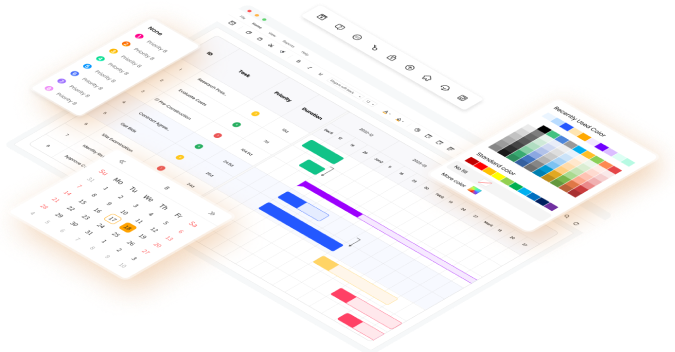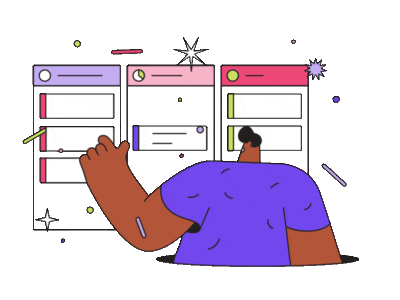
Project management is applying knowledge, proven techniques, skills, and tools to start and finish a project. For success in project management you should start with project planning.
Project planning is a critical phase in the lifecycle of any project, laying the foundation for its success or failure. It involves a meticulous process of setting goals, defining tasks, allocating resources, and establishing timelines.
This article will guide you through the essentials of project planning, highlighting its significance in achieving project objectives efficiently and effectively. We will explore different types and phases of project planning and how to make a project plan. Whether you are a seasoned professional or new to project management, this article will provide valuable insights for mastering project planning.
What is Project Planning?
Project planning is an essential step in managing any project. It's all about creating a detailed plan that clearly states what the project aims to achieve and what it will involve. The plan sets specific goals and defines the project's boundaries, which helps to keep the work focused and prevent doing more than what was initially planned. It also involves setting a schedule with deadlines, ensuring the project moves forward in a timely manner.
The second part of project planning involves organizing resources like the team, tools, and budget needed for the project. The plan also covers how to communicate with everyone involved, handle potential problems, and keep things on track. This careful organization and preparation are key to making sure the project runs smoothly from the beginning to its successful completion.
Why Is Project Planning Important?
Project planning is important because it's like making a roadmap for a project. It helps everyone know what needs to be done, when, and how. Without planning, projects can get messy, take longer, and cost more. It also helps avoid surprises and problems, because you think about what could go wrong and make plans to handle it.
Good planning makes sure everyone involved understands their tasks and how their work fits into the bigger picture. This means the project is more likely to succeed and achieve what it was supposed to do. Plus, it helps keep the project on budget and on time.
Types of Project Planning

There are three most common types of project planning depending on the nature of the project: vertical planning, horizontal planning, and joint planning
1. Vertical planning
Vertical planning, (also called waterfall planning), is an old-school method of project planning. In vertical planning, all the project's tasks that lead to the project's end goal are listed from the first to the last one and in a sequence. This means the team has to complete one task before proceeding to the next and the next one until the last task.
This type of planning is best suited for physical products with a repetitive process and predictable results. Vertical planning is a bit rigid as it assumes everything is available and there'll be no surprise bottlenecks, which means you can't deviate from the initial plans.
2. Agile Planning
Agile Planning, also known as horizontal planning, is where different project parts run concurrently. In agile planning, the name of the game is flexibility; the team works on small pieces of the projects quickly, sees what's working and what is not, changes what needs to be changed, and adopts the methodologies that work. This type of project planning aims to help the team be flexible and be better communicators as there's need for frequent communication. This method is unsuitable for projects with tight budgets as there's a lot of uncertainty.
3. Joint planning
Joint planning, or hybrid planning, combines the waterfall and the agile planning methods. Combining the two can be challenging, but a little guidance to the stakeholders goes a long way. It also means the projects may take longer to finish as decisions will take longer, and there may be a lot of repetition, especially if responsibilities and timelines need to be clarified. However, it is not all doom and gloom, especially if the project manager is conversant in the three types of project planning in project management.
Phases of the Project Life Cycle
Every project has a life cycle, no matter its size; for better and easier execution, it needs to be broken down into phases. According to The Project Management Institute (INSERT SOURCE), every project is divided into 5 phases and these are;
- Initiation: This is the first step of project planning, and it involves defining the project's goals and objectives. This step also conducts a feasibility study to see the project's practicality and suitability.
- Planning: In this project planning phase, the scope is defined by breaking down the work structure. The other things decided in this stage are the type of project planning (project methodology), the project's cost, resources and quality estimation, task dependencies, and the project's schedule complete with milestones. The main deliverable here is the project plan.
- Execution: This is where everything happens; it starts with the first meeting, where everything is communicated to the people involved in the project. As the project is ongoing, regular meetings are held where status reports are tabled regularly to see if timelines are tallying with the timestamps. It is the project's longest phase.
- Monitoring and controlling: This phase is not a phase per se, as it happens concurrently with the execution phase. The monitoring and controlling phase ensures the project is going as planned and aligns with its plan on paper.
- Closure and Review: This is the last step, where the stakeholders or the client get the final deliverable, and any pending payments are released, contracts to signify the project is finished are signed off, and the projection is evaluated for success or failure.
How Do You Create a Project Plan?
To have the perfect project plan, you should take enough time to create a project plan and ensure it has these steps;
- Define stakeholders: A stakeholder is anyone interested in the project; they include the client or the customer, project team members, the end user, and anyone affected inside or outside the organization.
- Introduce the stakeholders: This is where a first meeting is held to introduce all the stakeholders and to unify the project's vision. The things highlighted in this stage are, the scope of the project, the goals, and the projected budget, the schedule of the project, and the roles and responsibilities of each stakeholder.
- List the needed resources: List down everything you need to start, execute, and finish the project. List down the personnel required and their salaries, the materials and equipment needed, their cost, and anything else that might be necessary.
- Set goals: Take the points from the first meeting and put them together into a project; there should be goals and deliverables in the stipulated timelines, whether a product or a service.
- Prioritize tasks and create a schedule: Now that goals and deliverables are in place, list all the tasks in order of importance and interdependence. You can use charts, for example, a Gantt, to map out the schedule.
- Identifying the risks: Identify all the risks that might stall the project and develop strategies to mitigate them.
- Communicate: Share the project plan with stakeholders and keep communication lines open to update all the stakeholders on the project's development depending on the agreed-upon frequency.
- Reassess: As the project is ongoing, keep revisiting the project to see if the milestones are met as forecasted and revise the areas that need fixing.
- Evaluation: The project is complete, and it is time to evaluate success or failure to see what was learned and what can be improved in the next project.
An Example of Project Planning

Company B plans to open another office in a new town (Town A), and the operations manager has been tasked to foresee the new branch's opening and setup. Here's the project plan;
Project Name: Expansion to New Office in Town A
Project scope: Establish a fully functional office in Town A; this involves selecting a location, financial planning, and legal compliance, set up of infrastructure, staffing, and marketing
Project Objectives:
- Location selection: Identify the most strategic location in Town A that's close to all the amenities needed for the smooth running of the new office
- Onboarding at least 1000 new customers within the first month of opening
- Return on Investment in the first three months of opening
Project timelines: Start on December 1, 2023, and finish within six months
Stakeholders:
- Project Sponsor: Bank of America
- Project Manager: Mr. Alex Smith
- Development and Design: Ms. Claire Johnson
- Marketing team: Leah Watson and Alice Haughton
- Support team: Dennis Johnson and Elizabeth White
Project costs
Budget: $500,000
- Location and real estate: $200,000
- Legal compliance: $50,000
- Office setup: $125,000
- Contingency: $50,000
- IT and communication: $50,000
- Staffing: $50,000
- Marketing: $25,000
Risks and Mitigation:
- Location issues- ensure due diligence before settling on the location
- Legal delays- work with all the relevant authorities and start as early as possible
- IT setbacks- Get the best professionals
- Staffing problems: Start the hiring process as early as possible
- Market competition- conduct proper market research and adapt to the environment
- Budget overruns- shop for the best deals before starting and continually monitor the budget
Project Execution and Monitoring: Daily overseeing by the project manager, daily calls if the manager is not at the site, and weekly physical meetings with the team.
Communication Plan: Have weekly team meetings to see what's working and what is not, and turn in monthly reports to the headquarters to see if the set milestones are delivered on time. Weekly communication through marketing to bring new clients to the new office.
Project Closure
Review the project to see if everything worked as planned and to close the report as the new office is officially opened on May 31, 2024. Conduct post-launch performance and make the necessary adjustments.
Best Practices for Project Planning
1. Choose the Right Tool
Selecting appropriate project management tools is essential for effective planning and execution. These tools can range from software for task management and scheduling to communication platforms for team collaboration. For example, EdrawProj is a versatile project planning tool that cover all needs in project planning, including task management, resource allocation, and execution monitoring. Also, it offers a free versions which provides access to most basic functions.
2. Document everything
Keep detailed documentation of all aspects of the project. This not only helps in maintaining clarity throughout the project lifecycle but also serves as a reference for future projects.
3. Engage stakeholders
Keep regular communication with all stakeholders, including team members, clients, and sponsors. Understand their needs and expectations, and keep them informed about the project's progress.
Conclusion
Project planning is creating a plan that defines the start and the finish of a project. The plan should cover all the project’s details ranging from its goals, scope, tasks, cost, deliverables and deadlines. A project plan is a clear roadmap of the project to all the stakeholders; it is an accountability tool for everyone involved in the project. To keep headaches and frustrations at bay, it is important to have a project plan to guide you on the milestones and ensure deadlines are met.
A professional Gantt chart tool to plan, manage and track your projects, process and resources.



